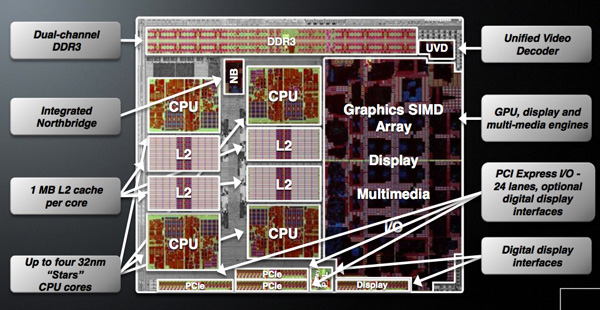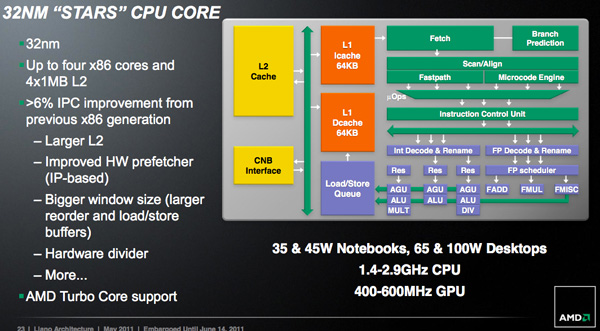The AMD Llano Notebook Review: Competing in the Mobile Market
by Jarred Walton & Anand Lal Shimpi on June 14, 2011 12:01 AM ESTThe Llano A-Series APU
Although Llano is targeted solely at the mainstream, it is home to a number of firsts for AMD. This is AMD's first chip built on a 32nm SOI process at GlobalFoundries, it is AMD's first microprocessor to feature more than a billion transistors, and as you'll soon see it's the first platform with integrated graphics that's actually worth a damn.
AMD is building two distinct versions of Llano, although only one will be available at launch. There's the quad-core, or big Llano, with four 32nm CPU cores and a 400 core GPU. This chip weighs in at 1.45 billion transistors, nearly 50% more than Sandy Bridge. Around half of the chip is dedicated to the GPU however, so those are tightly packed transistors resulting in a die size that's only 5% larger than Sandy Bridge.
| CPU Specification Comparison | ||||||||
| CPU | Manufacturing Process | Cores | Transistor Count | Die Size | ||||
| AMD Llano 4C | 32nm | 4 | 1.45B | 228mm2 | ||||
| AMD Llano 2C | 32nm | 2 | 758M | ? | ||||
| AMD Thuban 6C | 45nm | 6 | 904M | 346mm2 | ||||
| AMD Deneb 4C | 45nm | 4 | 758M | 258mm2 | ||||
| Intel Gulftown 6C | 32nm | 6 | 1.17B | 240mm2 | ||||
| Intel Nehalem/Bloomfield 4C | 45nm | 4 | 731M | 263mm2 | ||||
| Intel Sandy Bridge 4C | 32nm | 4 | 995M | 216mm2 | ||||
| Intel Lynnfield 4C | 45nm | 4 | 774M | 296mm2 | ||||
| Intel Clarkdale 2C | 32nm | 2 | 384M | 81mm2 | ||||
| Intel Sandy Bridge 2C (GT1) | 32nm | 2 | 504M | 131mm2 | ||||
| Intel Sandy Bridge 2C (GT2) | 32nm | 2 | 624M | 149mm2 | ||||
Given the transistor count, big Llano has a deceptively small amount of cache for the CPU cores. There is no large catch-all L3 and definitely no shared SRAM between the CPU and GPU, just a 1MB private L2 cache per core. That's more L2 cache than either the 45nm quad-core Athlon II or Phenom II parts.

Intel's Sandy Bridge die is only ~20% GPU
The little Llano is a 758 million transistor dual-core version with only 240 GPU cores. Cache sizes are unchanged; little Llano is just a smaller version for lower price points. Initially both quad- and dual-core parts will be serviced by the same 1.45B transistor die. Defective chips will have unused cores fused off and will be sold as dual-core parts. This isn't anything unusual, AMD, Intel and NVIDIA all use die harvesting as part of their overall silicon strategy. The key here is that in the coming months AMD will eventually introduce a dedicated little Llano die to avoid wasting fully functional big Llano parts on the dual-core market. This distinction is important as it indicates that AMD isn't relying on die harvesting in the long run but rather has a targeted strategy for separate market segments.
Architecturally AMD has made some minor updates to each Llano core. AMD is promising more than a 6% increase in instructions executed per clock (IPC) for the Llano cores vs. their 45nm Athlon II/Phenom II predecessors. The increase in IPC is due to the larger L2 cache, larger reorder and load/store buffers, new divide hardware, and improved hardware prefetchers.
On average I measured around a 3% performance improvement at the same clock speed as AMD's 45nm parts. Peak performance improved up to 14% however most of the gains were down in the 3—5% range. This is arguably the biggest problem that faces Llano. AMD's Phenom architecture debuted in 2007 and was updated in 2009. Llanos cores have been sitting around for the past 3-4 years with only a mild update while Intel has been through two tocks in the same timeframe. A ~6% increase in IPC isn't anywhere near close enough to bridge the gap left by Nehalem and Sandy Bridge.
Note that this comparison is without AMD's Turbo Core enabled, but more on that later.












177 Comments
View All Comments
CyanLite - Tuesday, June 14, 2011 - link
Looks very interesting. Getting one ASAP. Looks like AMD is back.therealnickdanger - Tuesday, June 14, 2011 - link
Yeah, back behind Intel yet again. If the price is right (cheaper than Intel) and the form factor is right (super thin and light notebooks), then I would consider this over SNB. Right now you can get entry-level SNB with medium-quality discrete AMD or NVIDIA graphics for under $700 that will more than match this notebook on GPU performance, battery life, and then proceed to run circles around it in CPU performance. $650 isn't a very good starting point. I hope they work down into that $500-600 bracket soon.Shadowmaster625 - Tuesday, June 14, 2011 - link
I dont get all the talk of $600-$800. There is fundamentally no reason why we wont see these chips in $449 back to school specials, or black friday specials. It is only $50 more in parts vs what we're seeing on slickdeals for $400.For example, this is from today: Lenovo ThinkPad Edge E520 15.6" Notebook Laptop: Core i3-2310M (2.10GHz), 4GB DDR3, 320GB 7200RPM, DVD Super Multi, Intel HD Graphics, HDMI, Win 7 Pro $434 Shipped
That is a $200 ripoff chip from intel. In a $450 notebook deal.
mino - Tuesday, June 14, 2011 - link
Go troll somewhere else.Intel managed to book a bunch of Quad+Discrete while preventing any dual+HD chips in this review providing a fine level of reality distortion field.
But that field does not reality change. Period.
Samus - Wednesday, June 15, 2011 - link
Well considering it will be cheaper than Intel (significantly when considering the additional cost of a comparable $50+ graphics card) and it uses less power than just about any SNB configuration, I think you answered your own questions.8steve8 - Tuesday, June 14, 2011 - link
eh, while this offers modest improvements over sandy bridge in games, the general cpu performance is pretty poor. If gaming is that important to you, then you won't be happy with EITHER IGP, so you'll still be better off with sandy bridge (paired with another gpu).That said, if they were free, I'd buy one. So they could still be a winner in the market if the price is right.
ash9 - Tuesday, June 14, 2011 - link
operative word is mobile - Who number crunches on a laptop anyway?8steve8 - Tuesday, June 14, 2011 - link
well mobile computers are becoming primary machines for many people. It's not just about "crunching numbers" everything non-3d-gaming is limited by storage,cpu, or memory bandwidth. try using a netbook, they aren't a pain to use because of their graphics, storage or memory bandwidth, they suck cause of their cpu performance.duploxxx - Tuesday, June 14, 2011 - link
that is why you probably have an Atom :) perhaps try an E-350 and see how much usable it is in a daily task.Broheim - Tuesday, June 14, 2011 - link
E-350 isn't an improvement over Atom in the CPU department,.